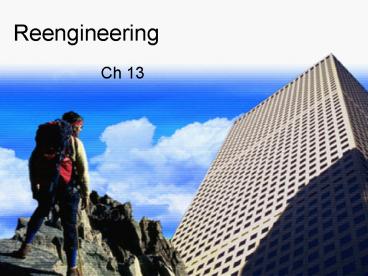Reengineering PowerPoint PPT Presentation
Title: Reengineering
1
Reengineering
- Ch 13
2
History
- Arthur Demings focus on total quality management
(TQM) helped Japan recover after World War II.
- "We have learned to live in a world of mistakes
and defective products as if they were necessary
to life. It is time to adopt a new philosophy in
America."
3
History
- Demings TQM theory met resistance from the
information/computer theory proponents in the
70s. - Michael Hammer introduced the Business Process
Reengineering concept when he wrote that TQMs
focus on eliminating redundancy and streamlining
business processes were essential for success and
productivity.
4
Introduction
- When programs exist without systematic
evaluation, attempts to add programming or
introduce new interventions will often compound
already existing problems. - Without process, impact, and outcome evaluation
methods, innovation is impossible.
5
Solutions?
- Reengineering programs to become the health
resource that they should be. - Demonstrating value added to the business.
- Partnering with other departments or employee
groups and programs and increasing ownership and
program effectiveness. - Reaching deeper into diverse populations with
more efficient services. - Moving stagnant programs forward.
- Fostering an organizational culture that
reinforces healthy lifestyles. - Becoming a part of the business plan not just
that wellness program.
6
Key Elements
- Process Focused
- Registration must be analyzed for efficiency,
duplication, areas of success and improvement - Managing Change and Risk gtgtgt How?
- Change a situational, eliminatory process
- Transition dealing with change
- Documented Improvement
- Be sure to document all measurable elements of
the program
7
Managing Change/Transition
- Determine what individual behavior and attitude
will have to be for the change to work. - Analyze who stands to gain, and who to lose,
something under the new system. - Effectively sell the problem to ensure individual
buy-in. - Provide precontemplators or the disgruntled to
voice their concerns. - Ensure the staff understand change and transition
concepts. - Hold regular meetings to discuss problems.
- Always ensure an free flow of ideas and
suggestions.
PowerShow.com is a leading presentation sharing website. It has millions of presentations already uploaded and available with 1,000s more being uploaded by its users every day. Whatever your area of interest, here you’ll be able to find and view presentations you’ll love and possibly download. And, best of all, it is completely free and easy to use.
You might even have a presentation you’d like to share with others. If so, just upload it to PowerShow.com. We’ll convert it to an HTML5 slideshow that includes all the media types you’ve already added: audio, video, music, pictures, animations and transition effects. Then you can share it with your target audience as well as PowerShow.com’s millions of monthly visitors. And, again, it’s all free.
About the Developers
PowerShow.com is brought to you by CrystalGraphics, the award-winning developer and market-leading publisher of rich-media enhancement products for presentations. Our product offerings include millions of PowerPoint templates, diagrams, animated 3D characters and more.

